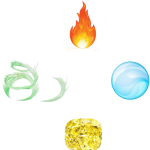Fred Erickx
 In the homeopathic anthropological model it’s the Vital Force that maintains the organism in equilibrium. The Vital Force according to Hahnemann have two forces.
In the homeopathic anthropological model it’s the Vital Force that maintains the organism in equilibrium. The Vital Force according to Hahnemann have two forces.
The Force of generation
The tendency to imbalance is possible because of the ability of the vital force to resonate with pathogenic processes (exogenous or endogenous) and to produce symptoms. It is in German “Erzeugungskraft” (Organon § 21): Force of generation or production. This means that the energy of the pathogenic process resonates with the vital energy and generates a dis-attunement of this vital energy. It is the ability of vital energy to receive another energy and to give birth to a pathogenic process. Once this pathogenic process is initiated, it will develop and grow without a natural tendency to cure.
The global disorganization – which immediately affects the overall system- manifests into peripheral somatic or psychic symptoms. A symptom or disease located in an organ is not an isolated entity from the rest of the organism but the localized manifestation of the global imbalance.
In the human body, homeopaths have shown that the disorganization evolves from bottom to top (from toes to head), from the outside inward (from the skin to the internal organs), from the superficial to the deep organs (for example joints to the heart or brain) and from a superficial emotional state to a neurosis or psychosis (Hering’s Law).
The Force of conservation
Facing this generated imbalance, the vital force tends to react, in order to maintain homeostasis, it is in German “Erhaltungskraft” which means force of preservation or conservation. This second quality is the ability to oppose the unbalancing primary action. This opposite secondary response, opposite in direction and intensity to primary action, is the self-preservation ability of the vital force. Hahnemann talks about it at § 63: ” ” Every power that acts on life, every medicine, alters the vital force more or less and brings about in human health certain modifications of greater or lesser duration. We call this the primary action. Although it is a product of both the medicinal and the vital force, this primary action nevertheless belongs more to the domain of the former. Our vital force strives to oppose its energy to this influence. This, its life-preserving reaction “erhaltungskraft”, is an automatic activity called secondary action or counteraction.”
However if this force of opposition is able to maintain homeostasis in the usual circumstances of life, the genesis of a chronic disease in the vital energy of the individual cannot be overcome by this force and requires intervention of a similar medicinal force that will neutralize by resonance the natural disease.

In homeopathy, we balance the ground or the constitution. To do this the homeopathic practitioner looks for a remedy, called the simillimum, who will play this role.
This research is not a simple task and to simplify it, we have developed a method to diagnose the nature of the Kingdom that the patient needs: mineral, plant or animal.
The integrative typology model (ITM) proposes a classification based on the four elements of the tradition earth, water, fire and air. Thus, according to Oriental medicines, each person has a constitution with a dominant element. There are earth constitutions, water constitutions, etc…
The diagnosis of the constitution makes it possible to determine the Kingdom that the patient needs.
Here is the correspondence:
- Earth: Mineral Remedy
- Water and fire: Animal remedy
- Air: Plant Remedy.
In a very schematic way:
The earth gives a sense of concrete, perseverance and a great need for security. Water gives charm, compassion, seduction, emotion and a great need for affection. Fire gives vivacity, fighting spirit, clarity and a great need for justice. Finally, Air gives efficiency, curiosity, motivation and a great need to feel recognized.
I am currently writing a book intended for homeopathic practitioners: constitutional homeopathy, Tome 1, Diagnosis of the Kingdom, which should come out in the first semester 2019. Stay tuned!

genotype and phenotype
The phenotype is the whole set of characters (or psycho-physical traits) we can observe on an individual. Traditional Ayurvedic Medicine classifies all human phenotypes in three big taxons (dosha): Wind (Vata), Bile (Pita) and Phlegm (Kapha). All the homeopathic remedies represents a particular phenotype and can fit into these three categories. For example (according to our researches) Sulfur is Wind-dominant, Lachesis Phlegm-dominant and Iodum Bile-dominant.
In front of a patient, we need to determine to which Dosha/humor does he belong, and this will direct the choice of a remedy that belongs to this phenotype. This is called the constitutional or phenotypical similar. It’s thus possible to say that my patient has for example a Sulfur phenotype.
Each of the three phenotypical taxons have physiological weaknesses.The most similar remedy, the simillimum, will allow a better regulation of their genomic expression and modify the phenotype for a better health.
This website is dedicated to the homeopathic treatment of chronic diseases and a new level in the law of similar, the constitutional similar.
We already knew local similar that applies to acute diseases and to palliation in incurable chronic diseases and global similar.
Global similar applies to both constitutional diseases and chronic infectious diseases, two kinds of diseases that Hahnemann distinguished.
Constitutional similar is a specialization of the global similar applied to constitutional diseases. It is based on a new tool, the integrative typology model that allows to diagnose the constitution, classify all the remedies of the materia medica and to apply the law of similar at this level, i.e. in case of constitutional diseases (psoric) to give a remedy that belong to the constitution of the patient.
This website is presenting the basics fundamentals and practical applications of this new concept and is essentially written for professional homeopaths but it will be beneficial for lay persons as well.







